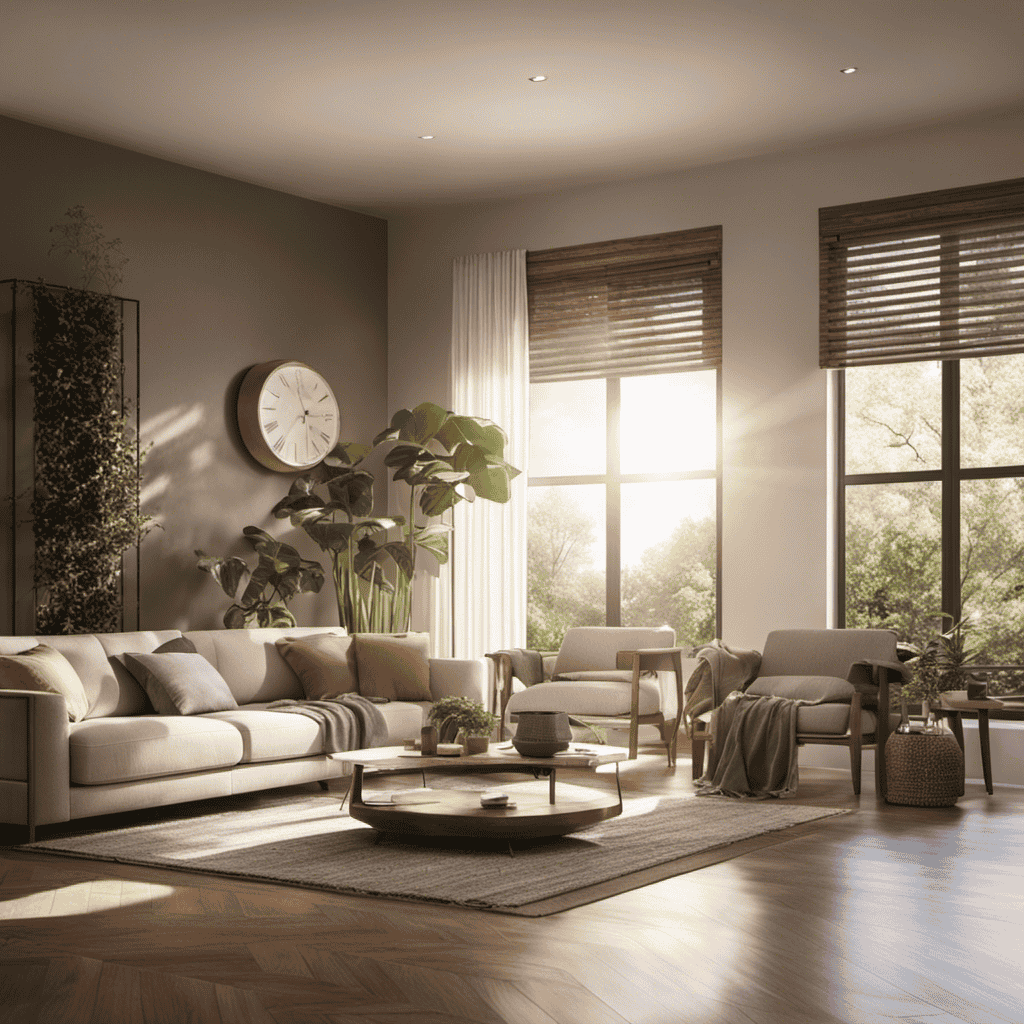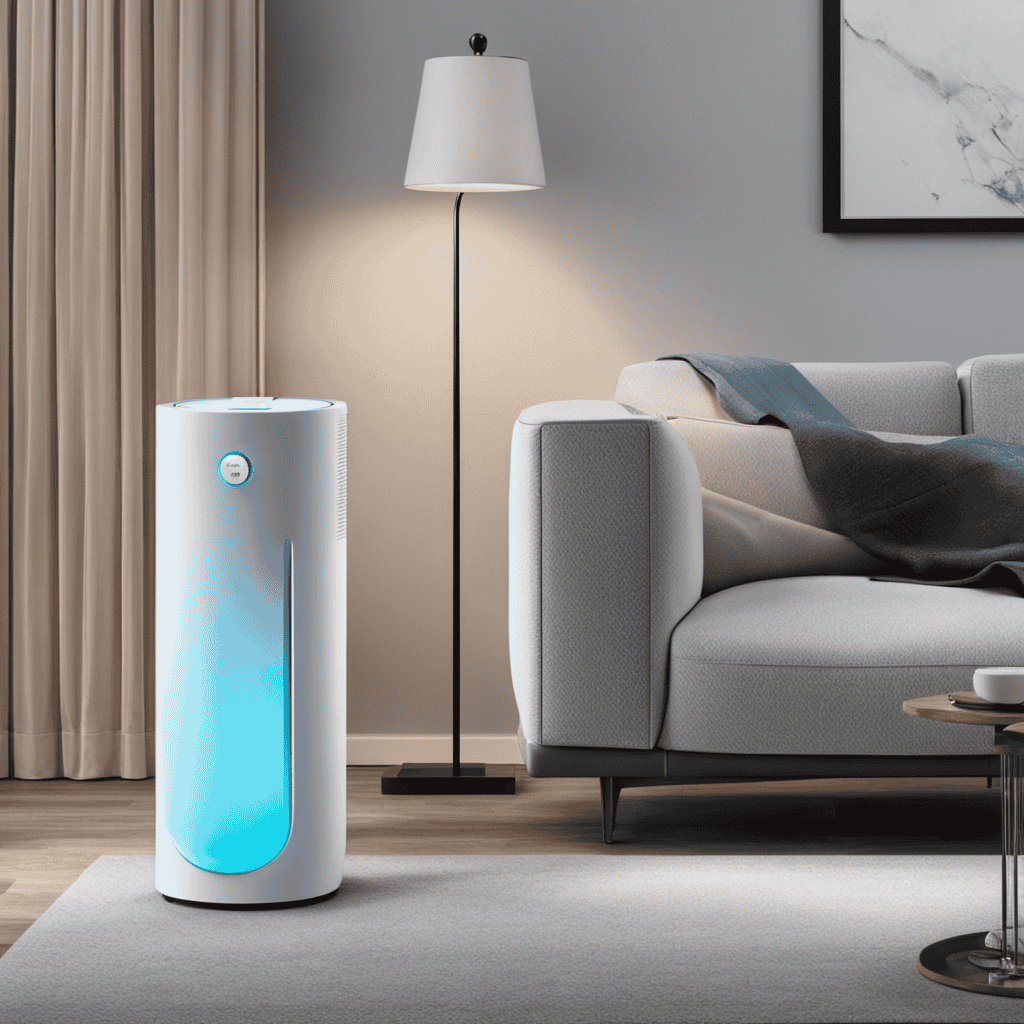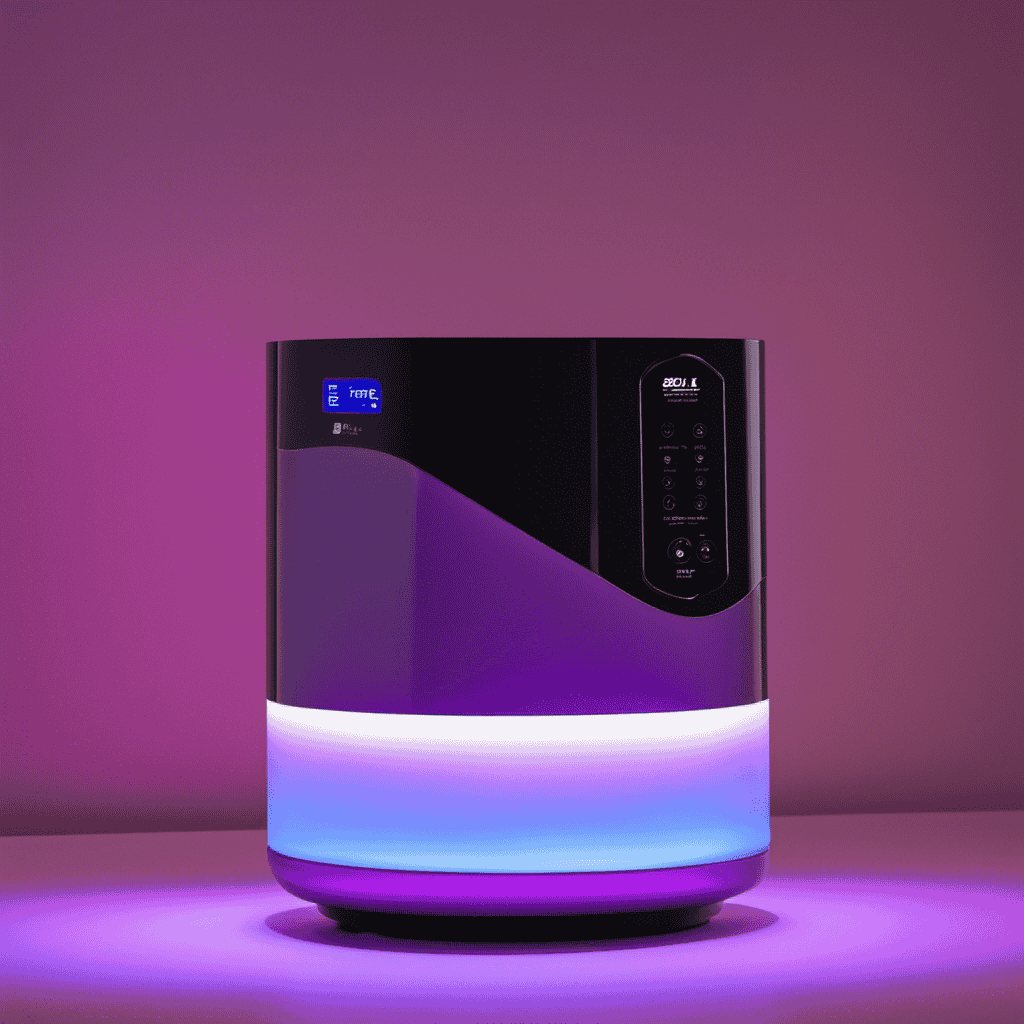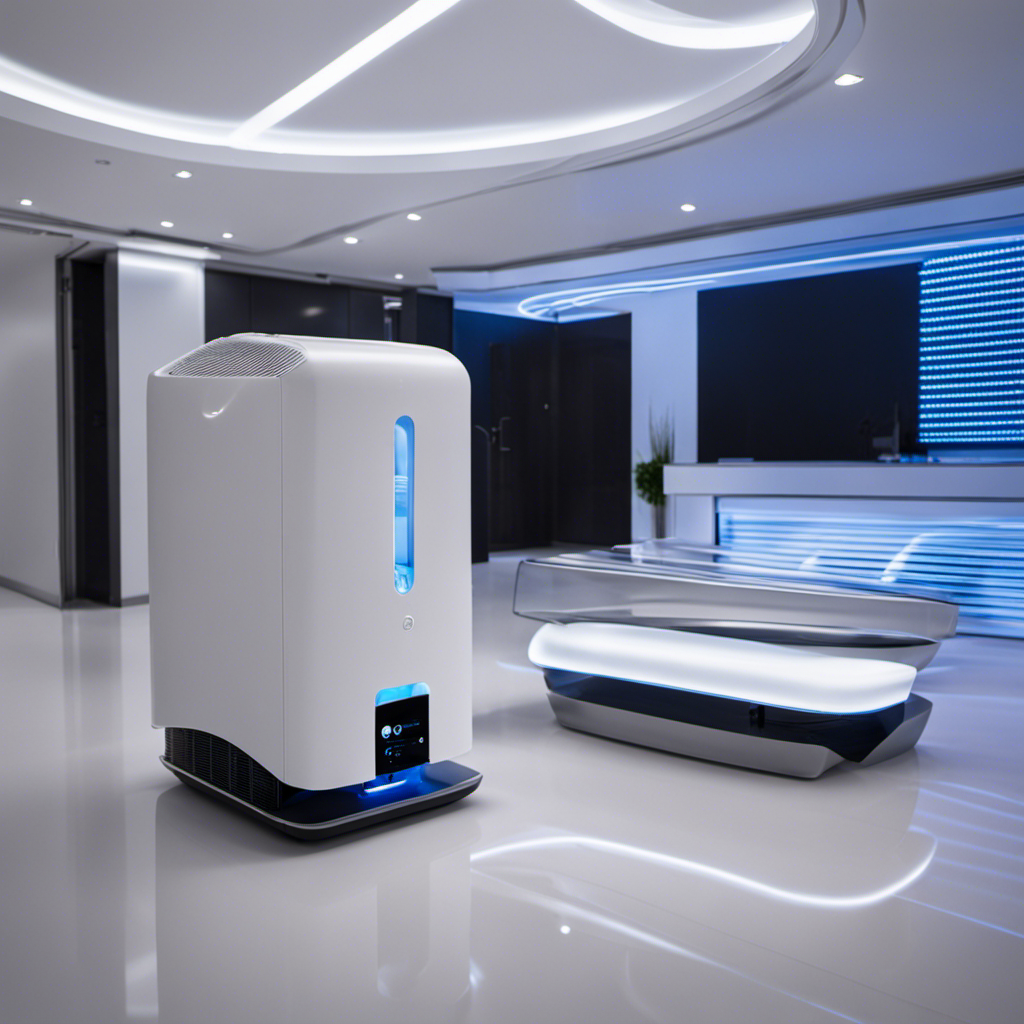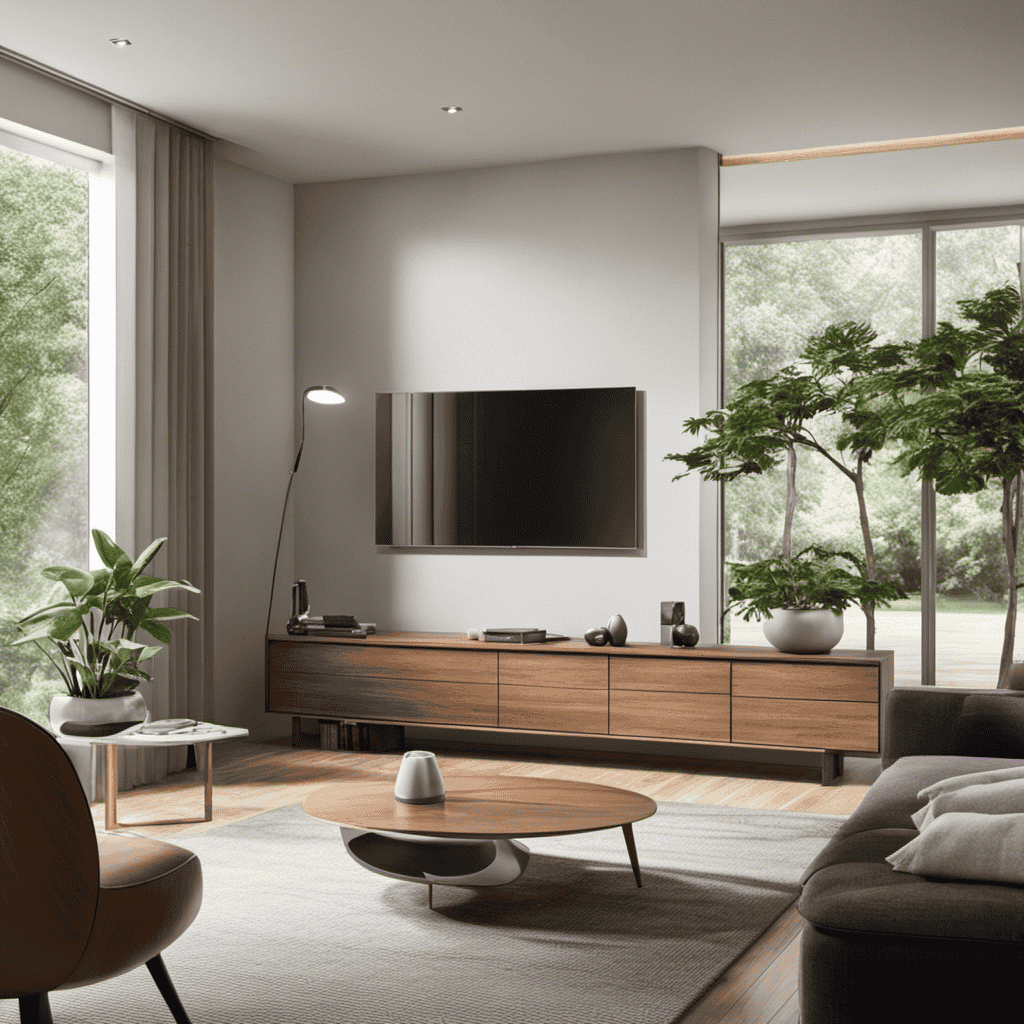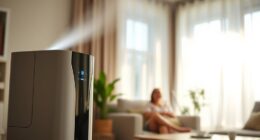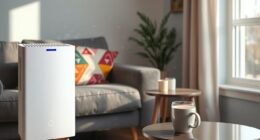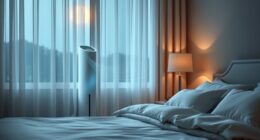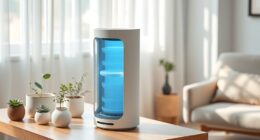It is crucial to grasp the daily usage of air purifiers.
With so many factors to consider, such as room size and indoor air quality, determining the right amount of time to run your air purifier can be a daunting task.
That’s why I’m here to provide you with research-based insights and recommendations on how many hours you should be running your air purifier each day.
Let’s dive in and optimize your air purification routine for maximum effectiveness.
Key Takeaways
- Running an air purifier for at least 8 hours a day is recommended for optimal performance.
- Factors such as room size, air quality, and personal preferences influence the recommended usage of an air purifier.
- Manufacturer’s guidelines should be followed to determine the recommended hours of operation.
- Adjusting the fan speed to a lower setting and placing the air purifier in the right location with proper airflow can optimize its efficiency and reduce energy consumption.
Understanding the Daily Usage of Air Purifiers
Air purifiers can be used for several hours a day to effectively clean the air in your home. Daily air purifier usage is important for maintaining good indoor air quality. It is recommended to run your air purifier for at least 8 hours a day to ensure optimal performance.
This duration allows the air purifier to continuously filter out pollutants such as dust, allergens, and airborne particles. However, it is crucial to note that regular maintenance of your air purifier is equally important. Cleaning or replacing the filters on a regular basis ensures that the air purifier remains efficient in capturing pollutants.
Neglecting maintenance can lead to reduced performance and compromised air quality. Therefore, it is essential to understand the importance of air purifier maintenance to maximize its effectiveness in providing clean and fresh air in your home.
Moving forward, let’s explore the factors to consider when determining air purifier usage.
Factors to Consider When Determining Air Purifier Usage
When determining how long to use your air purifier each day, you should consider factors such as room size, air quality, and personal preferences. The recommended usage of an air purifier can vary depending on these factors. For example, in smaller rooms, the air purifier may need to run for a shorter time compared to larger rooms. Additionally, if the air quality in your area is poor or if you have allergies or respiratory issues, you may need to run the air purifier for longer periods to achieve optimal air quality control. Personal preferences also play a role, as some individuals may prefer to have the air purifier running continuously, while others may choose to use it only when needed.
| Factors to Consider | Recommended Usage |
|---|---|
| Room Size | Smaller rooms: 4-6 hours per day Larger rooms: 8-12 hours per day |
| Air Quality | Poor air quality: 8-12 hours per day Moderate air quality: 4-8 hours per day Good air quality: 2-4 hours per day |
| Personal Preferences | Continuous usage: 24 hours per day Intermittent usage: As needed or desired |
Recommended Hours of Operation for Air Purifiers
After researching the topic of optimal daily air purifier usage, I’ve found several key points to consider.
-
Determine the recommended hours of operation for air purifiers. Understanding the manufacturer’s guidelines on how long to run your air purifier can help ensure its effectiveness in improving indoor air quality.
-
Understand the factors that can affect usage time. Factors such as room size, air quality, and specific health concerns can influence how long you should run your air purifier each day.
-
Learn about energy-saving operation tips. Implementing energy-saving practices, like using the air purifier on a lower fan speed or utilizing timers, can help minimize energy consumption while still maintaining clean air.
Optimal Daily Air Purifier Usage
To get the most out of your air purifier, you should use it for a few hours every day. Continuous air purification can greatly improve indoor air quality and provide numerous health benefits. The optimal air purifier settings may vary depending on factors such as room size, air pollution levels, and personal preference. A general guideline is to run the air purifier on a medium or high fan speed for 4-6 hours per day. This allows for effective removal of airborne pollutants, such as dust, pollen, pet dander, and mold spores. However, it’s important to note that some air purifiers are designed for continuous operation and can be left running 24/7. Here is a table outlining the benefits of continuous air purification:
| Benefits of Continuous Air Purification |
|---|
| 1. Constant removal of airborne pollutants |
| 2. Improved indoor air quality |
| 3. Reduced allergy and asthma symptoms |
| 4. Enhanced sleep quality |
Factors Affecting Usage Time
Factors like room size, pollution levels, and personal preference can affect how long you should use an air purifier each day. When determining the recommended usage hours, it is important to consider these factors to ensure optimal air purification.
Room size plays a significant role in the effectiveness of an air purifier. Larger rooms may require longer usage to achieve desired air quality.
Pollution levels also impact usage time. High pollution levels may necessitate extended usage to continuously filter and clean the air.
Additionally, personal preference should be taken into account. Some individuals may prefer to run the air purifier for longer periods to maintain a consistently clean environment.
It is recommended to consult the manufacturer’s guidelines and consider these factors to determine the appropriate usage hours for your specific needs.
Energy-Saving Operation Tips
One way to save energy when using an air purifier is by adjusting the fan speed to a lower setting. By doing so, you can still effectively clean the air in your space while minimizing the energy consumption of the device.
Additionally, it is recommended to keep the air purifier running continuously, as turning it on and off frequently can use more energy and reduce its overall efficiency.
Another energy-saving tip is to ensure that the air purifier is placed in the right location, away from obstacles and with proper airflow. This will allow the device to operate optimally and maximize its efficiency in purifying the air.
By implementing these energy-saving tips, you can reduce the energy consumption of your air purifier while still enjoying its benefits of clean and healthy air.
In the next section, we will discuss how long you should run your air purifier each day to achieve the desired results.
How Long Should You Run Your Air Purifier Each Day
It’s important to consider how long you should run your air purifier each day for optimal effectiveness. Daily air purifier usage depends on several factors, including room size, air quality, and individual needs. To help you determine the ideal usage, I have created a table below:
| Factors to Consider | Recommended Daily Usage |
|---|---|
| Room Size | 6-8 hours |
| Air Quality | 4-6 hours |
| Allergies/Asthma/COPD | 8-10 hours |
| Odor Control/Pet Dander | 10-12 hours |
These recommendations are based on scientific research and industry standards. However, it’s crucial to note that each situation may vary, and it’s best to consult the manufacturer’s guidelines for your specific air purifier model. Now, let’s explore the relationship between room size and air purifier usage.
The Relationship Between Room Size and Air Purifier Usage
When determining how long to run your air purifier daily, consider the relationship between room size and usage. The size of the room directly affects the efficiency of the air purifier. A larger room requires a more powerful air purifier to effectively clean the air. This is because the air purifier needs to circulate and filter a greater volume of air in a larger space.
In contrast, a smaller room would require a less powerful air purifier. It is important to choose an air purifier with a sufficient Clean Air Delivery Rate (CADR) that matches the size of your room. By considering the room size correlation and selecting the appropriate air purifier, you can ensure optimal air purification and energy efficiency.
Transitioning to adjusting air purifier usage based on indoor air quality, let’s explore how to effectively monitor and control the air purification process.
Adjusting Air Purifier Usage Based on Indoor Air Quality
In order to optimize the performance of an air purifier, it is essential to adjust its settings based on the indoor air quality. Monitoring the air quality regularly allows me to determine the appropriate adjustments needed to maintain a clean and healthy environment.
By using air quality sensors or monitoring devices, I can accurately assess the levels of pollutants such as dust, pollen, and volatile organic compounds (VOCs) in my home. If the air quality is poor, I can increase the fan speed or activate additional purification modes to effectively remove these pollutants.
On the other hand, if the air quality is good, I can reduce the fan speed or switch to a lower power mode to conserve energy. Regularly adjusting the air purifier settings based on indoor air quality ensures that I am providing the most optimal conditions for clean and fresh air in my home.
Balancing Energy Consumption and Air Purification Effectiveness
By finding a balance between energy consumption and air purification effectiveness, I can ensure that my home remains clean and fresh without using excessive power. When it comes to air purifiers, it is important to consider their energy efficiency.
Investing in energy efficient air purifiers not only helps to reduce electricity bills, but also minimizes the environmental impact. These air purifiers are designed to operate on low power levels without compromising their air cleaning capabilities. By using energy efficient models, I can maintain a healthy indoor environment while being mindful of my energy usage.
Additionally, the long term health benefits of using air purifiers cannot be overlooked. They help to remove pollutants, allergens, and airborne particles, improving the overall air quality and reducing the risk of respiratory problems.
With the right balance between energy consumption and air purification effectiveness, I can create a clean and healthy living space for myself and my family.
Tips for Optimizing Air Purifier Usage Throughout the Day
To get the most out of your air purifier, it’s important to optimize its usage throughout the day. By following these tips, you can maximize its effectiveness while reducing energy consumption.
Start by setting a schedule for your air purifier based on your daily activities. For example, you can turn it on in the morning when you wake up and leave it running until you leave the house. Then, set it to turn on again in the evening when you return home. This way, you ensure that the air is constantly being purified when you are at home, without wasting energy when you are not.
Another way to optimize usage is by adjusting the fan speed. Most air purifiers have different speed settings, allowing you to choose between low, medium, or high. Running the air purifier on a lower speed can help reduce energy consumption while still maintaining effective air purification.
Lastly, make sure to clean or replace the filters regularly. Clogged filters can reduce the purifier’s effectiveness and increase energy consumption. Refer to the manufacturer’s instructions for guidance on how often to clean or replace the filters.
By implementing these strategies, you can make the most of your air purifier while minimizing energy usage.
| Tips for Optimizing Air Purifier Usage Throughout the Day |
|---|
| Set a schedule based on your daily activities |
| Adjust the fan speed to reduce energy consumption |
| Clean or replace filters regularly |
Frequently Asked Questions
Can I Run My Air Purifier 24/7?
Yes, you can run your air purifier 24/7, but it’s not recommended. It can lead to increased energy consumption and may not be necessary if you only need air purification during specific times of the day.
Are There Any Health Risks Associated With Running an Air Purifier for Long Periods of Time?
Running an air purifier for long periods of time may have health benefits by improving indoor air quality. However, it is important to perform regular maintenance to prevent the accumulation of pollutants and ensure optimal functionality.
Can I Sleep With My Air Purifier On?
I sleep with my air purifier on for the numerous benefits it provides, such as reducing allergens and improving air quality. Although it may produce some noise, it is worth it for a good night’s sleep.
Should I Turn off My Air Purifier When I Leave the House?
I turn off my air purifier when I leave the house to save energy and prolong its lifespan. This practice reduces the air purifier’s energy consumption and minimizes the need for frequent maintenance.
Can I Use Multiple Air Purifiers in One Room for Better Air Quality?
Using multiple air purifiers in one room can improve air quality by increasing the coverage area and reducing pollutants faster. However, it’s important to consider the room size, filter types, and noise levels to maximize the benefits.
Conclusion
In conclusion, after conducting extensive research and analysis, it’s recommended that individuals run their air purifiers for a minimum of 8 hours a day to effectively improve indoor air quality.
However, this may vary depending on factors such as room size and air pollution levels.
Like a vigilant guardian, an air purifier diligently eliminates harmful particles. It’s like a knight protecting its castle from invaders.
By optimizing air purifier usage throughout the day, we can create a healthy and safe environment. This ensures the well-being of ourselves and our loved ones.
